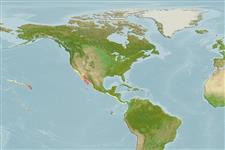>
Gobiiformes (Gobies) >
Gobiidae (Gobies) > Gobiinae
Etymology: Barbulifer: Latin barba,-ae; barbula = beard + Latin, fero = to carry (Ref. 45335).
More on author: Pellegrin.
Environment: milieu / climate zone / depth range / distribution range
Ecologia
marinhas demersal; intervalo de profundidade 0 - 32 m (Ref. 92840). Subtropical
Eastern Central Pacific: Gulf of California.
Tamanho / Peso / Idade
Maturity: Lm ? range ? - ? cm
Max length : 5.2 cm SL macho/indeterminado; (Ref. 11482)
Descrição suscinta
Chaves de identificação | Morfologia | Morfometria
Characterized by the presence of barbels on the head and complete absence of scales (Ref. 92840).
Cryptic species; usually found hiding under rocks or near the base of sponges or algae, reaches depths of 32 m (Ref. 92840).
Ciclo de vida ou comportamento de acasalamento
Maturidade | Reprodução | Desova | Ovos | Fecundidade | Larvas
Allen, G.R. and D.R. Robertson, 1994. Fishes of the tropical eastern Pacific. University of Hawaii Press, Honolulu. 332 p. (Ref. 11482)
Status na Lista Vermelha da UICN (Ref. 130435: Version 2024-1)
Ameaça para os humanos
Harmless
Uso pelos humanos
Pescarias: sem interesse
Ferramentas
Relatórios especiais
Baixar XML
Fontes da internet
Estimates based on models
Preferred temperature (Ref.
123201): 22.3 - 28, mean 25 °C (based on 185 cells).
Índice de diversidade filogenética (Ref.
82804): PD
50 = 0.5312 [Uniqueness, from 0.5 = low to 2.0 = high].
Bayesian length-weight: a=0.00955 (0.00561 - 0.01627), b=3.15 (3.01 - 3.29), in cm total length, based on LWR estimates for this species & (Sub)family-body (Ref.
93245).
Nível Trófico (Ref.
69278): 3.2 ±0.3 se; based on size and trophs of closest relatives
Resiliência (Ref.
120179): Elevada, tempo mínimo de duplicação da população menor que 15 meses (Preliminary K or Fecundity.).
Fishing Vulnerability (Ref.
59153): Low vulnerability (10 of 100).
